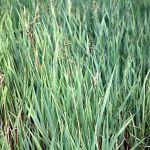| Common Name: |
Sweet Grass |
| Other Names: |
Holy grass, Vanilla grass, zubrovka |
| Botanical Name: |
Hierohloë odorata syn. H. borealis. |
| Genus: |
Hierochloë |
| Family: |
Poaceae |
| Native Location: |
Circumboreal |
| Cultivation: |
Well-drained, moisture-retentive soil in sun. |
| Propagation: |
By division of rhizomes in spring and summer. |
| Harvest: |
Leaves are cut in summer, dried, and stored whole, or distilled for oil. |
| Height: |
25-50cm (10-20in) |
| Width: |
40-60cm (16-24in) |
| Hardiness: |
Z3-9 |
| Parts Used: |
Leaves, oil. |
| Properties: |
An aromatic herb, with a strong vanilla scent, that acts as an excitant in perfumes and as a fixative for other scents. |
| Economic Uses: |
Leaves are added to vodka as a flavoring (Poland). They are also in demand for basket weaving. Oil is used to flavor candy, soft drinks, and tobacco. Essential oil is used in perfumery. |
| Bibliography: |
Encyclopedia of Herbs by Deni Brown Copyright © 1995, 2001 Dorling Kindersley Limited Pp 235-236 |

